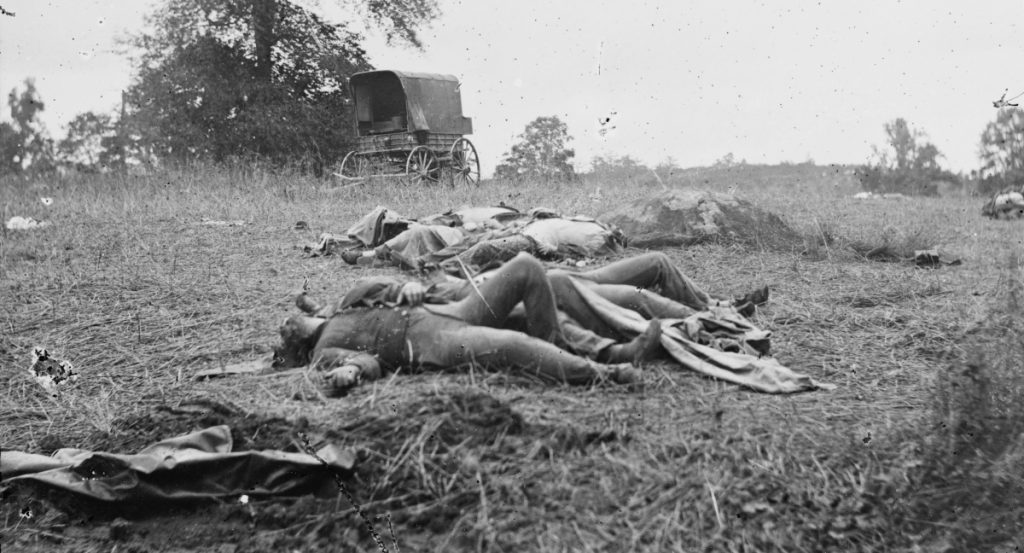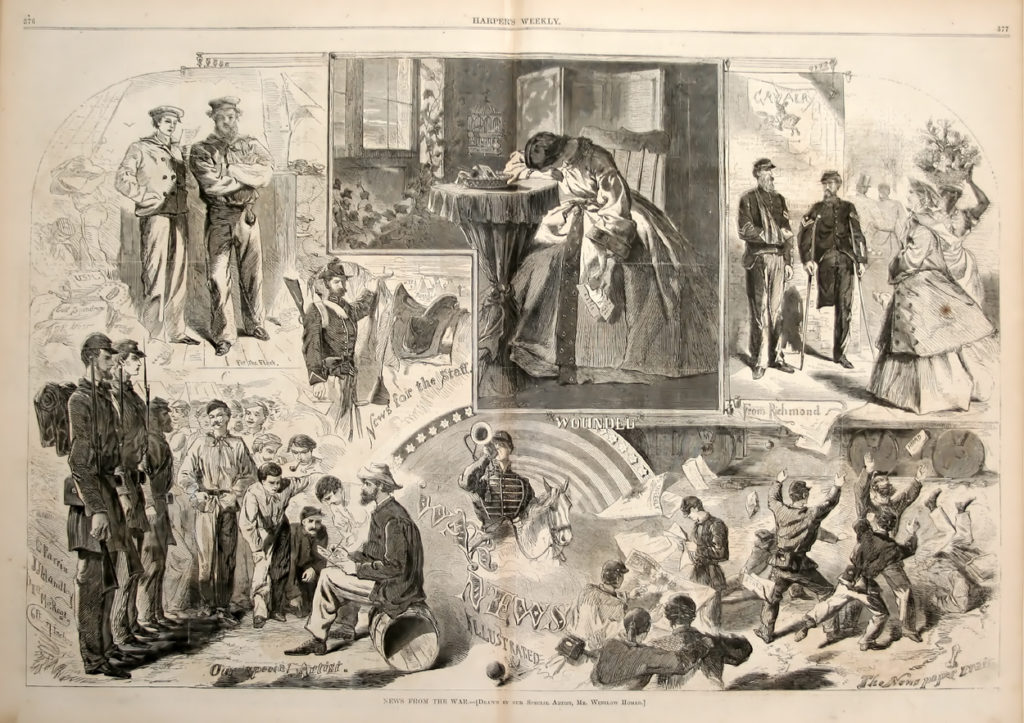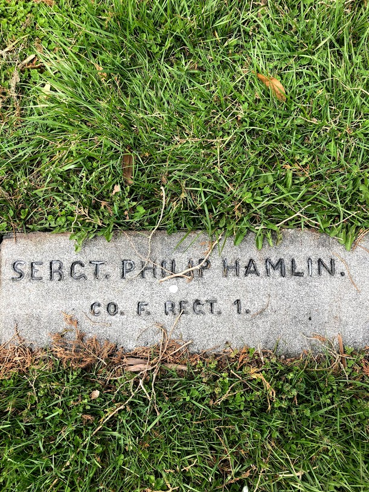Table of Contents
Museum members support scholarship like this.
19th Century Americans lived in a world that celebrated death, whether the deceased be old, young, or cut down in the prime. Americans especially celebrated a disposition of recognition and acceptance in the face of death. Contemporary culture labeled this the Good Death. It was expected for one to pass away peacefully at home surrounded by loved ones, who could bear witness to the dying’s acceptance of their fate and record their last words, typically declarations of religious faith.[1] The Civil War challenged beliefs about the Good Death as scores of young men died anonymous deaths on battlefields far from home. As soldiers died in the chaos on the battlefield, or passed surrounded by strangers in a hospital, it was clear that America’s culture of death required adaptation to face this cruel reality.

To counter the lack of recorded last words and to symbolically replace the remains of soldiers that were rarely sent home, dying soldier poems became increasingly common as a mourning rite. [2] These poems imagined deathbed moments for absent family members, thereby assuring readers of the propriety of an individual’s death. The genre began during the Mexican American war, where death from combat and disease foreshadowed the challenges that Americans would face during the Civil War. [3] Deaths away from the immediate presence of family combined with the significant distance between home front and war front posed significant challenges to the way that 19th Century Americans mourned. Creation of highly idealized literary constructions of one’s dying moments helped loved ones imagine that the deceased experienced a Good Death instead of an ignoble anonymous one.[4]
Dying soldier poems were a natural extension of the poetic form that had long been used by theologians and intellectuals to shape public discourse about death. In the early years of the war, poetry tapped into the enthusiastic patriotism and played a significant role in shaping public opinion about the war. Poems urged men to enlist and to be heroic in battle, while urging civilians to support the war effort – and accept the inevitably of battlefield casualties. Even through the first two years of the Civil War, poetry was used in funeral rites, further linking the form with its function of mourning the dead.[5]

Writers
turned to dying soldier poems after 1863 to perform the important cultural task
of making individual battlefield deaths meaningful in the face of mounting
casualty lists.[6]
These poems continually featured common themes central to contemporary
sentimental cultural: eternal life, female loved ones, the dying’s last words,
and brave acceptance of their fate.[7]
The dying soldier poem written mourning Philip Hamlin of the 1st Minnesota, killed on July 3rd, 1863 at the battle of Gettysburg is a useful example of the ways that narratives were constructed to give meaning to battlefield deaths. Hamlin’s family was notified of his death by his close comrade Sergeant James Wright in a letter that described Hamlin as “an earnest and consistent Christian.”[8] The letter also described Hamlin as prepared for his death, allowing him to attain at least one feature of the esteemed Good Death. Wright’s letter emphasizes that Hamlin never wavered in his faith and did not become hardened by the horrors of war. The description was rooted in truth as Hamlin’s letters throughout the war are full of religious sentiments, including his final letter home concluding “Oh, it is sweet to trust in the All Seeing One…because he is such a savior, I have hope.”[9] The contents of Wright’s condolence letter to the family provided the inspiration for the poem below written by Mrs. Mary F. Harmon, wife of Rev. Stephen D. Tandy, the pastor of the Methodist church where the Hamlin family worshipped. The Hamlin family were founding members of Pine Island’s Methodist church and were deeply involved in the community, so Harmon would have known Philip and been invested in ensuring he achieved a Good Death.
In Memory of Philip Rice Hamlin
Killed in Action
Gettysburg, Pennsylvania
3 July 1863
When our country called for succor,
Bidding home and friends farewell,
Fearing not to give his young life,
For his country loved so well,
—
He was noble in his actions,
Dutiful to parents dear,
Gentle, loving kind, forbearing,
Ah, how much they miss him here.
—
Where the battle raged the wildest,
In the thickest of the fight,
Fell he like a hero, bravely,
Proudly battling for the right.
—
Far away from home and kindred,
Loving Mother, Father dear,
Gentle Sister, youthful Brothers,
Ne’er again his voice shall hear.
—
Soon there came a white-winged missive,
Written by a friendly hand.
Fraught with words of tender solace
To that stricken family band.
—
“Tis a task to write this letter,
Painful news have I to tell,
On the second day of battle,
Sergeant Philip Hamlin fell.
—
From his bowed head I severed
One dark tress of waving hair.
Tore a bit from off his colors,
Folded them with reverent care.
—
‘Neath the shadow of the wildwood
There we made his lowly bed.
Left him there to rest unbroken
With the silent nameless dead.
—
Here’s the small but sacred token;
Well I know his Mother’s heart.
Will be cheered by this memento
Though from him she’s called to part.”
—
Death for Philip had no terrors.
He was strong in faith and love.
Hopeful, trusting, patient ever,
Living for his home above.
—
Father, Mother, all ye loved ones,
Though you meet on earth no more
Far from war and raging tumult,
Safe you’ll meet on Canaan’s shore.[10]
Mrs. S.D. Tandy – Canon Falls, MN – Upon hearing of Philip’s Death

Harmon’s narrative links Hamlin’s acceptance of death with the Victorian cultural emphasis on heaven. Mid-19th century Americans believed heaven was a material place where bodies and souls would be perfected, and where family and friends would be restored. Though their son would be buried in Gettysburg, Hamlin’s family was assured by the poem’s reference to Heaven that the family would be reunited. By invoking heaven, “death poetry salved the pain of earthly separation for its readers” while simultaneously holding the deceased up as an earthly example.[11] The poem also notes “the small but sacred token” that would cheer his Mother’s heart -a reference both to the lock of Hamlin’s hair included with Wright’s condolence letter and also a reference to the poem. These tokens performed the important task of satisfying survivors yearning to know their loved one was not forever lost.[12]
The emphasis on Hamlin’s mother throughout the poem demonstrates how wartime literature depicted women’s wartime role in rearing – and sacrificing if necessary- their sons for the sake of the country.[13] Women connected the flag and the nation for soldiers since community sewing groups often gifted flags to departing regiments.[14] In addition to the lock of hair sent home, the condolence letter from Wright included “a bit of our tattered flag, which he loved so well.”[15] The flag gave Hamlin’s sacrifice a dual meaning, one for his family and one for his nation. By remaining loyal to and loving the flag, Hamlin remained loyal to and loved his mother. Hamlin’s mother shaped and molded her young son, but his ultimate sacrifice for the nation was a decision outside of her hands. Alice Fahs notes that writers made clear that the “unbearable passivity of women’s role, in which the chief war work allowed them was intense feeling, itself caused enormous suffering.”[16] Philip’s mother, Elizabeth, was no stranger to wartime suffering, Philip’s death at Gettysburg would be followed by the death of her second oldest son, Jacob, at the battle of Nashville a year later.

Dying soldier poems were an adaptation to the challenges that prevented attainment of the Good Death. The prevalence of these narratives reflect the cultural world of mid-19th century Americans that believed that to die in war was a beautiful thing and those who perished on the battlefield should be celebrated as noble and heroic martyrs.[17] Dying soldier narratives provided the culturally aspired Good Death to those whose actual, anonymous and gruesome deaths away from home fell short of cultural expectations. Readers were subsequently able to celebrate the heroic sacrifice of the dead, even when they died far away from home.[18] For the family of Philip Hamlin, the dying soldier poem written created meaning in his individual sacrifice amidst crushing casualty figures.
Learn more in this interview with Cameron Sauers, the post’s author
Want to learn more? Follow us on Facebook and Twitter to discover more stories from Civil War medicine!
Become a museum member and support our educational programs and research like this.
About the Author
Cameron Sauers is a student at Gettysburg College, where he is a History major with minors in Public History and Civil War Era studies. Cameron is a Fellow at the Civil War Institute and is currently Co-Editor in Chief of the Gettysburg College Journal of the Civil War Era. Portions of this article come from research Cameron conducted as the 2019 Sandy Abend Summer Research Fellow at the Civil War Institute. Cameron can be reached on twitter @cam_sauers
Endnotes
[1] Drew Gilpin Faust, This Republic of Suffering: Death and the American Civil War. (New York: Knopf, 2008), 10-11.
[2] Richards, Battle Lines, 57.
[3] Mark Schantz, Awaiting the Heavenly Country: The Civil War and America’s Culture of Death. (Ithaca, Cornell University Press, 2008), 101.
[4] Schantz, Awaiting the Heavenly Country, 19 – 30, 121
[5] Fahs, The Imagined Civil War, 88.
[6] Faust, This Republic of Suffering, 177
[7] Schantz, Awaiting the Heavenly Country 106
[8] Sergeant James Wright to Rice Hamlin, July 6th 1863. From the Hamlin Family Papers, Minnesota Historical Society, St. Paul
[9] Philip Hamlin to Family, June 25 1863. Hamlin Family Papers from the Collections of the Minnesota Historical Society, St. Paul.
[10] Hamlin Family Papers, from the collection of the Minnesota Historical Society, St. Paul
[11] Schantz, Awaiting the Heavenly Country, 40.
[12] Faust, This Republic of Suffering, 180.
[13] Fahs, The Imagined Civil War, 122.
[14] Fahs, The Imagined Civil War, 123.
[15] Sergeant James Wright to Rice Hamlin, July 6th 1863. From the Hamlin Family Papers, Minnesota Historical Society, St. Paul
[16] Fahs, The Imagined Civil War, 134.
[17] Schantz, Awaiting the Heavenly Country, 19. Faust, This Republic of Suffering, 189.
[18] Schantz, Awaiting the Heavenly Country, 102.


